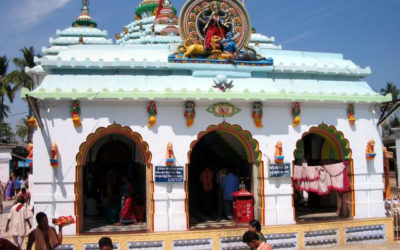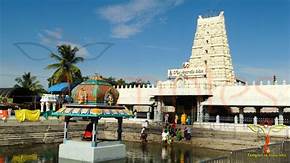DHARABHOGAPURAM/ RAMBILLI: This several centuries-old temple could have been well conserved by the department of archaeology. The beautifully sculpted pillars of the mandapam and the early 15th century stone inscriptions could be of interest to any history-lover. The picturesque setting of the sprawling temple below the foothills could delight tourists and make the tourism department interested. But the Shiva Temple at Panchadarla presents a sorry picture of neglect.
The Kotilingeswara Aalayam or Panchadarla temple is said to be built by the Eastern Chalukya Cholas in the ninth century. But the archaeology department does not seem to take any responsibility for properly maintaining or conserving this heritage structure.
At the water tank on the temple premises, which is fed by a perennial water source, hundreds of soaps and shampoo sachets are found floating. The premises are weeds grown and unkempt. There’s no guide to explain the significance or the history of the temple. What is worse is that the sculpted stone walls of the temple and mandapam, which are white-washed, are scribbled upon by visitors.

On Maha Sivaratri, the temple situated in Dharabhogapuram village near Yelamanchili, comes alive with the footfall of thousands of devotees, who also take a head bath in the tank. The temple derived its name Panchadarla from five jets of water coming out of five fountains, which receive their supplies from a natural perennial spring. Locals said the water, which is believed to wash away sins, has its source in Varanasi. It’s also said that on the Shivalingam there are other carved lingams in 12 rows of 85 each. This is why the temple is also known as kotilingam.

There are several inscriptions on the pillars of the mandapam and two of them date back to 1407 and 1428. These contain a genealogy of chiefs of the Eastern Chalukya ancestry and the Eastern Chalukya titles of Sarvalokasraya and Vishnu Vardana. Besides Maha Sivaratri, when around 5,000-8,000 people frequent the temple, there are also auspicious dates such as the Phalguna Suddh Pournami in March or Karthika masam when people gathers in large numbers. During these times, the presiding deity is taken out on a palanquin.

Temple priest Vamsi Krishna said, “Since entry to the temple is free of cost, no revenue is generated from devotees visiting the temple. Some meagre amount is donated at times to the hundi. But that is not enough for maintenance of the temple and staff. We manage our own expenditure from the agricultural land provided to us generations ago by the Vizianagaram rajas. As for the whitewash on the stone walls and pillars, it’s done on the request of the locals every year during the lord’s kalyanam, who aren’t aware of the archaeological or heritage value of the temple.”

Image Credit: Bharath Darshini
Section 144 Imposed At Sarala Temple, Bhagabati Temple In Jagatsinghpur, Odisha
District Magistrate Sangram Keshari Mohapatra today issued an order in this regard saying the...



0 Comments